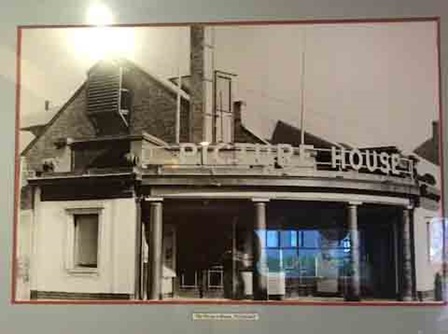This pub stands on the site of a malthouse – one of the outbuildings of nearby Dale House. Being on New Road (itself constructed around 1818 as a turnpike), Dale House was built for the Hincks family more than half a century earlier, whose malthouse was situated next door. The malthouse was later converted to The Coliseum – the first cinema on the site, which opened in 1914, on the eve of World War I.
Text about the history of The Malthouse.

The text reads: This J D Wetherspoon pub stands on the site of a malt house, which was one of the out buildings of nearby Dale House. The house was built around 1750 by the Hincks family, farmers who had come here from Bilson a century earlier and built up a malting business.
The malthouse was converted into a cinema around 1914. Called the Coliseum, it outlasted its rival, the White City, even though the Coliseum was so cramped that part of the film overlapped onto the ceiling.
Another early cinema was the Picture House on Gomer Street. This presented magic lantern shows and also the first films. However, it must have been closed by 1915, when a new Picture House, the town’s first purpose-built cinema, opened on the Market Place. This second Picture House closed in 1959.
In 1932, Dale House and the Coliseum were bought by John Tyler, a local councillor who ran a building and decorating business. He and his daughter Norah replaced the old Coliseum with a new cinema, the Dale, with seating for audiences of over 1,000.
The Dale opened in October 1932, showing the Technicolor sound film Viennese Nights. It continued as a cinema until 1967, when it made the almost inevitable transition into a bingo hall.
A print and text about Joseph Tonks.

The text reads: The clock in the nearby Market Place was put up in 1892 in memory of Joseph Tonks, a local surgeon.
With its drinking fountains, weather vane, lamps and water trough, it was paid for by public subscription, a sign of the affection Tonks won from the people of Willenhall.
The doctor was born in 1855. His parents, Silas and Lucy Tonks, kept the Forge Inn at Spring Bank, later renamed the Rushbrooke Farthing, after tokens issued by local grocer Joshua Rushbrooke.
Tonks was one of the people whose efforts gradually improved public health in Willenhall, a town with a bad reputation for unhealthy living conditions. Not only before he began working here, the town had suffered an epidemic of cholera, a disease usually the result of contaminated water supplies.
Tonks practised in the town for only a short time, dying at the early age of 35. However, he achieved great popularity amongst the poor, and the local friendly societies were instrumental in settling up his memorial.
Doctor Tonks married Clara, one of the 13 children of local manufacturer Jonah Banks. Jonah’s company in Clothier Street, Little London, was founded in 1790, and produced door-bolts for over two centuries before closing in 1993. Jonah and his firm are commemorated by Willenhall’s Banks Street.
Above: Dr Tonks.
A photograph of the Picture House, Willenhall.

If you have information on the history of this pub, then we’d like you to share it with us. Please e-mail all information to: pubhistories@jdwetherspoon.co.uk